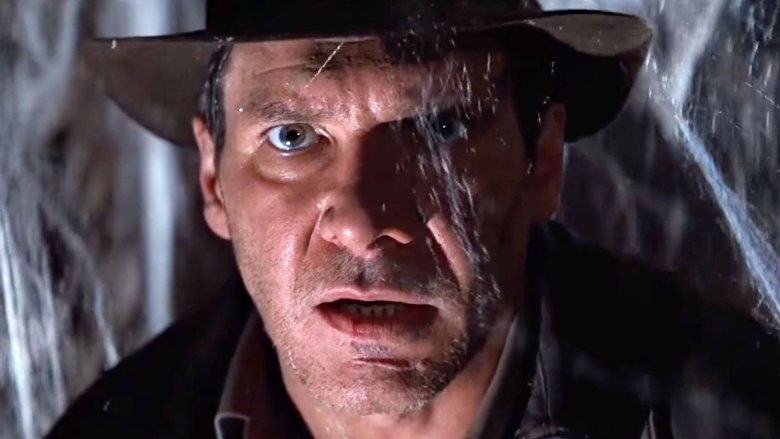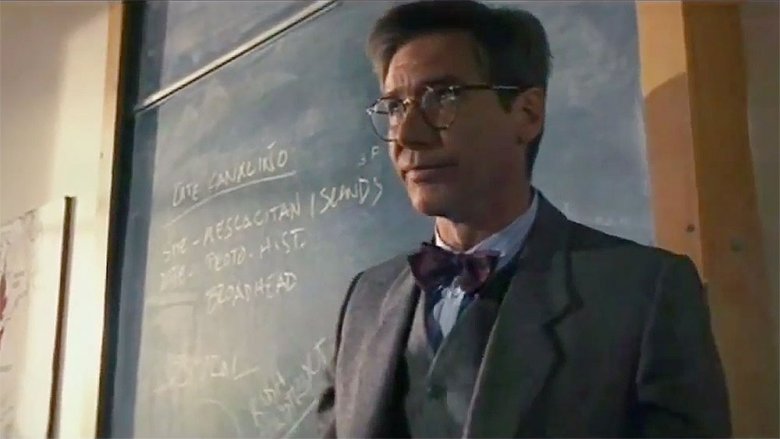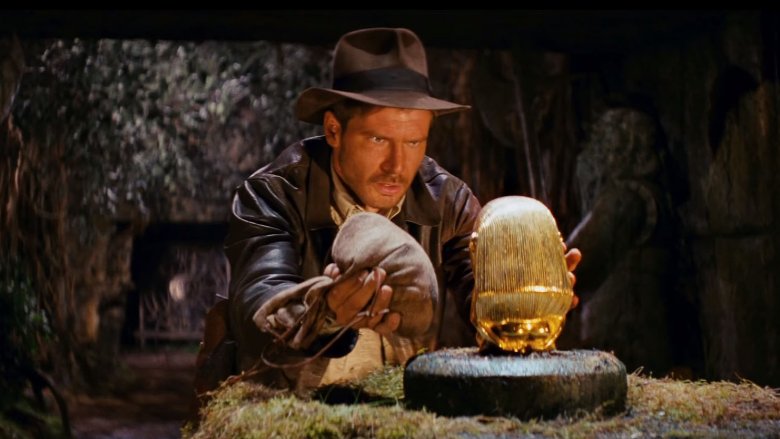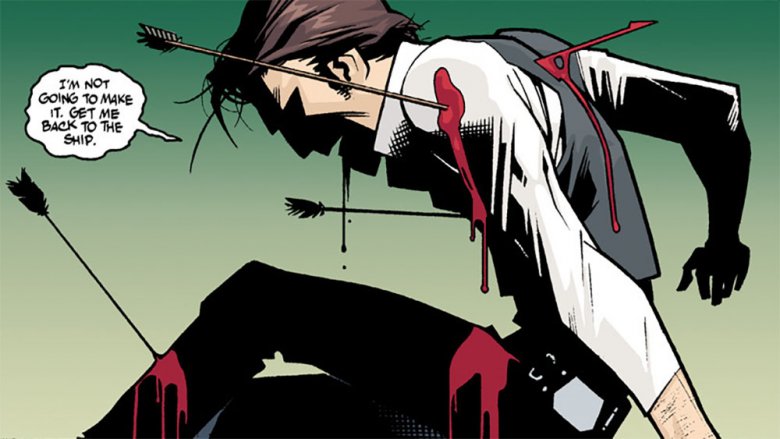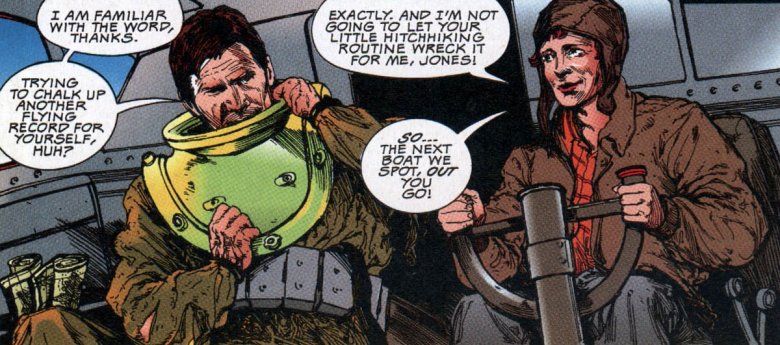The Most Terrible Things Indiana Jones Has Ever Done
Harrison Ford excels at playing lovable rogues—but when you get down to it, Indiana Jones is much more "rogue" than "lovable." Sure, Indy cracks a mean whip and he's a seasoned pro when it comes to making things up as he goes along, but a cocky swagger and well-timed quip can only carry you so far. Charisma doesn't excuse grave-robbing or supporting criminal syndicates, nor does it excuse Indy's troubling relationship with women.
Or, to put it another way: the dude wears a fedora. That should've been a red flag right at the start.
He seduced a child
When Marion Ravenwood and Indiana Jones meet in Raiders of the Lost Ark, it's not the first time they've crossed paths. They've got history. Remember, Marion decks Indy for a very good reason.
Roughly 10 years before Raiders, Marion had a fling with a much older Indiana. The exact size of the age gap is up for debate (actress Karen Allen was 30 when she played Marion the first time, while Harrison Ford was 39), but all evidence indicates that good ol' Indy is most likely a statutory rapist. During the original Raiders of the Lost Ark story meetings, George Lucas proposed that Indy "could have known this little girl when she was just a kid. Had an affair with her when she was 11." After Steven Spielberg protested, Lucas decided that "15 is right on the edge... Once she's 16 or 17, it's not interesting anymore."
In the official Raiders of the Lost Ark novelization, Marion is 15 when Indy starts sleeping with her, and he ditches her a year or two later. In the movie, Marion claims that she was "a child" during the affair, and Indiana doesn't deny it. Given the background information, it's easy to read between the lines: Indiana Jones slept with an underage girl, and we're supposed to shrug it off like it's no big deal.
He's a terrible professor
A university professor is expected to do two things: teach students, and produce scholarly articles. As far as anyone can tell, Indiana Jones doesn't really do either. While the audience sees Indy in the classroom once or twice, he seems willing to abandon his students at the drop of a hat when a good adventure comes calling. Forget office hours—if you're one of Professor Jones' students, you'll be lucky if he shows up to class at all (according to the Raiders of the Lost Ark's novelization, he also hooks up with his students—or at least their classmates—which, while not illegal, crosses all kinds of ethical boundaries).
Indy isn't much of a scholar either, at least according to real-life experts. While real archaeologists spend about 70 percent of their time in the library, Jones heads out into the field equipped with little more than rumors and hearsay. He never takes notes, and doesn't seem to write many journal articles—"What's his publication record?" one academic asks. When Indy does make discoveries, like the fully functional deathtrap-filled cave at the beginning of Raiders of the Lost Ark, he ignores them in favor of shiny but less historically important baubles. It's no wonder that, according to the satirical publication McSweeney's, Indiana Jones was denied tenure. He might be a hero, but as an academic, he's just not up to snuff.
He robs graves and steals artifacts
The other problem with Indiana Jones' professional conduct is that he's a thief, plain and simple. All those times Indy sneaks into temples or dig sites and takes valuable artifacts? That's what looters do, not researchers. As many archaeologists point out, the Nazis might've been bad dudes, but they apparently had permits to search for the Ark of the Covenant. Indy, who stealthed his way inside and tried to profit off their hard work, did not.
In fact, looting is a major problem for real-life archaeologists. The theft of artifacts hinders valuable research, while the antiquities trade is often used to fund terrorists, gunrunners, and drug smugglers. During the looting process, thieves often destroy their surroundings, robbing the scientific community of valuable information. Even Indy's claims that he's stealing his artifacts for science—like, say, claiming that the Cross of Coronado "belongs in a museum" during The Last Crusade—ring hollow. Just because Indiana Jones or some other thief finds an object doesn't mean it belongs to him, and stripping a country of its heritage in order to decorate foreign museums isn't just a big no-no, it's actually considered illegal. Just ask the Egyptian government, which has been trying recover its stolen artifacts for decades with varying degrees of success.
He worked for the mob
Remember the beginning of Indiana Jones and the Temple of Doom? If not, maybe this will refresh your memory: after a musical number, Indy saunters into Shanghai's Club Obi Wan clutching the ashes of an old Chinese emperor named Nurhachi. He's there to meet with Lao Che, a crime boss who's willing to trade Nurhachi's remains for the Peacock's Eye diamond. Despite Che's attempts to get the ashes without paying—Lao Che's son mugged Indy the previous evening, but didn't quite finish the job—Indiana is still willing to play ball.
The deal falls apart when Lao Che tries to poison Indiana and make off with both the diamond and the ashes, leading to a brawl, a chase scene, and a plane crash, but let's be clear: that's all on Lao Che. Not only did Indiana agree to work with a mobster, but he's happy to see the deal through to the end even after Lao Che makes an attempt on his life. That diamond is worth a lot of money, after all, and when there's cash at stake, ethics don't matter. Indy just can't say no.
He hunted Chewbacca
In Dark Horse Comics' Star Wars Tales #19, Harrison Ford's two most famous characters (sorry, Rick Deckard, you're great but you're decidedly second-tier) meet in an inter-series cross-over—kind of, anyway. In the first half of "Into the Great Unknown," Han Solo and Chewbacca find themselves, as they often do, pursued by Imperial forces. With the Millennium Falcon's navi-computer on the fritz, Solo must make a blind hyperspace jump in order to survive. When the Falcon emerges from lightspeed, it's in orbit around Earth—yes, our Earth—where Han decides to stop for repairs.
If you think you know where this is going, just wait: you probably don't. The Falcon crash-lands in the forest, and right as Han observes that the planet looks a lot like Endor, a tribe of Native Americans attack. Chewbacca fights them off, but not before the natives pump Han Solo full of arrows. This is where you'd expect Indiana Jones to swing to the rescue, escort Solo to safety, and save the day. But no: the smuggler bleeds out and dies in Chewbacca's arms.
Flash-forward 126 years. Indiana Jones, Short Round, and their Native American guide scour the forest, looking for Chewbacca, who's since become known as the legendary sasquatch. Their intent is clear: the tracker carries a rifle, while Indy quips that "the museum isn't paying for footprints." In other words, Indiana Jones is hunting his alter ego's best friend for cash. Whether or not Chewbacca survives the experience doesn't seem to make much difference.
Indy and his crew track Chewie to the Millennium Falcon, where they find Han Solo's arrow-ridden corpse. That gives Indy a strange sense of deja vu, and he's rattled enough to call off the hunt, thereby ending the most depressing crossover in Star Wars and Indiana Jones history.
He gave mystical artifacts to a madman
In a typical Indiana Jones story, the Americans are the good guys, and the Nazis and Russians aren't. Indiana Jones and the Infernal Machine, the 1999 Tomb Raider-inspired adventure game, is not a typical Indiana Jones story. Oh, sure, the plot starts out conventionally enough—for most of the game, Indy must scour the globe in search of religious artifacts (in this case, remnants of the Tower of Babel, which was actually a machine that opened inter-dimensional portals) while staying one step ahead of his enemies, a group of Soviet soldiers led by a physicist named Gennadi Volodnikov.
The end of Infernal Machine, however, turns every Indiana Jones trope on its head. Yes, the bad guys still manage to secure the artifacts. But in a big twist, it turns out that Volodnikov isn't that bad. Indy's CIA contact, Simon Turner, is. After Indiana turns over the machine parts to Turner for safekeeping, Turner opens an inter-dimensional portal all on his own, hoping to recruit the supernatural forces on the other side and help bring the Cold War to a swift conclusion. Turner locks Indy's love interest, Sophia, in a cage, and both she and Indy are sucked through a portal, where they fight an ancient Babylonian god before returning to the real world.
In other words, unlike Raiders of the Lost Ark's face-melting finale, Jones played a big part in Infernal Machine's climax. It's just not a good part. If Indiana hadn't handed the machine pieces to Turner, the portal never would've been unlocked, and everyone would've been fine—except for the players, of course, who would've been treated to a pretty lackluster ending.
He slept with the enemy
Indiana Jones' number one enemies are the Germans, right? Not only does he spend feature films fighting against the Third Reich, but in the Young Indiana Jones Chronicles television show, a teenaged Indy enlists in World War I and helps America fight against the Kaiser's forces.
And that's why it's a little surprising that Indiana Jones lost his virginity to a German spy. Not just any German spy, either: according to The Young Indiana Jones Chronicles, Indy engaged in a brief love affair with Mata Hari, a world-famous seductress, exotic dancer, and alleged German double agent who was executed for espionage in 1917. Indiana's brief role in Mata Hari's life took place in Paris, October in 1916 (literally—the episode is called "Paris, October 1916"), which, like every other episode of Chronicles, pairs the future archeologist with a real-life figure from history.
Unlike other Young Indiana Jones episodes, however, "Paris, October 1916" is known for being far more explicit than any other pieces of Indiana Jones media (except for maybe the novelization of the episode, which doesn't hold anything back). A kid-oriented edutainment show seems like a strange place to show Mata Hari belly dancing or to delve into teenage Indy's sex life, but it does explain Jones' flexibility when it comes to the age difference between his partners: while Indiana is 17 years old when the episode takes place, Mata Hari is over 40.
He ruined Amelia Earhart's record-breaking flight
These days, most people know Amelia Earhart because of her mysterious disappearance, but Earhart would never have attempted her ill-fated journey around the world if she hadn't already proved herself as a capable and fearless aviator. In 1932, Earhart became the first woman to cross the Atlantic solo via airplane—and only the second person to do it at all after Charles Lindbergh accomplished the feat in 1927—and the first woman to fly nonstop across the United States. In 1935, Earhart was the first person of either sex to fly solo from Hawaii to the continental U.S., leaving from Honolulu and landing in Oakland, California.
That last record is even more impressive, given that Indiana Jones did everything he could to stop her from succeeding. He wasn't being actively malicious, of course. As seen in Indiana Jones and the Shrine of the Sea Devil #4, Earhart and Indy are old friends. Still, it's not like she actually stops to give him a ride. After escaping the clutches of the titular Sea Devil (which most people would probably call a kraken), Indiana is stuck alone on a sinking ship in the middle of the Pacific. His chances of survival seem grim—when suddenly, a plane flies overhead. The plane doesn't stop, so Indy gathers some rope and lassos the plane's lower struts, then climbs onboard.
Given that weight distribution is a big concern while flying, Indy's reckless act of self-preservation could've easily upset the plane and doomed Earhart to an even earlier demise. Even though both survived, technically, Indy disrupted Earhart's record-setting attempt. Remember, she was trying to fly across the ocean solo, which means she couldn't have Indy on board. Thankfully for Earhart, she was able to drop Indiana off on the nearest ship, and Indy managed to keep his big mouth shut. According to the history books, Earhart's legacy is intact.
